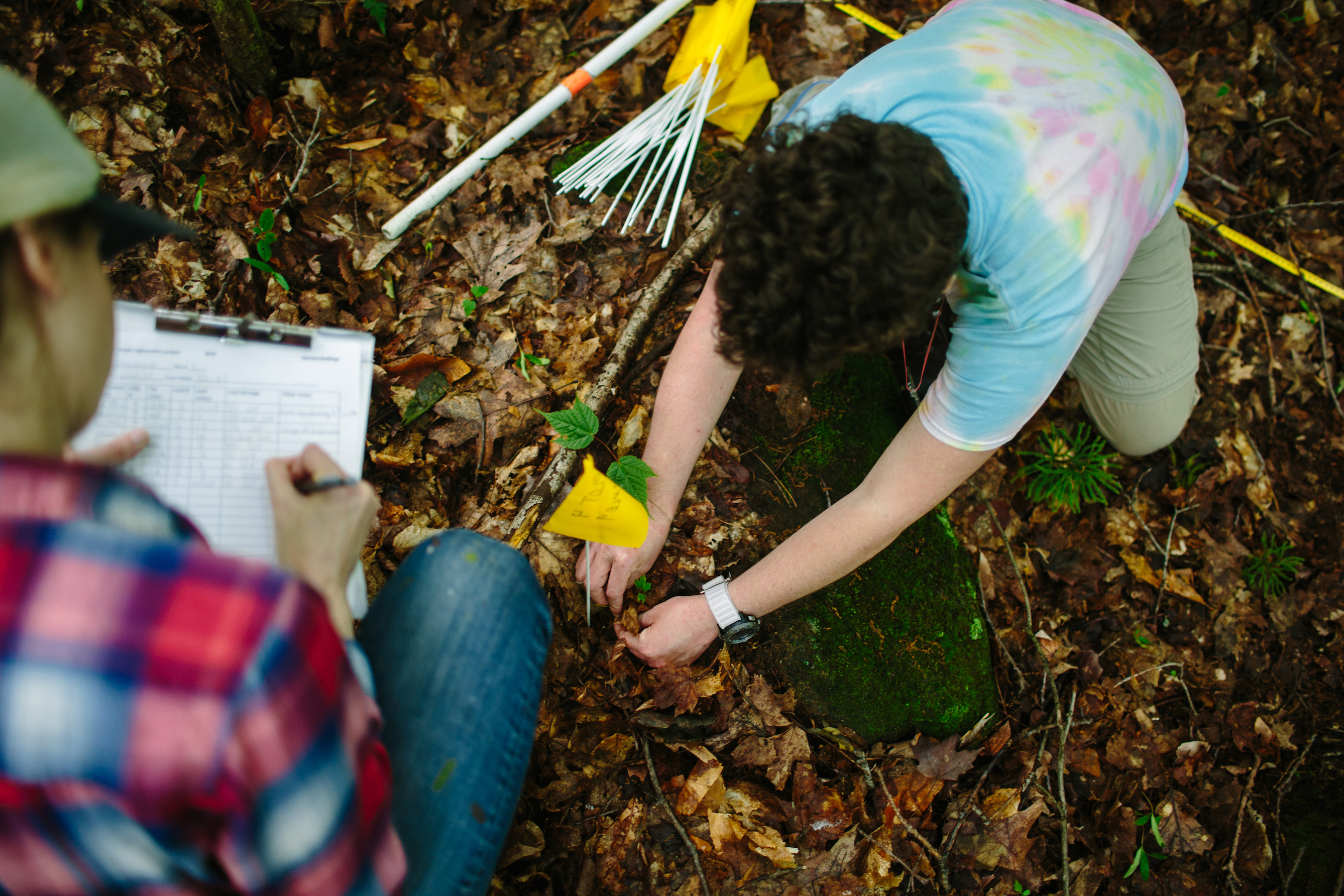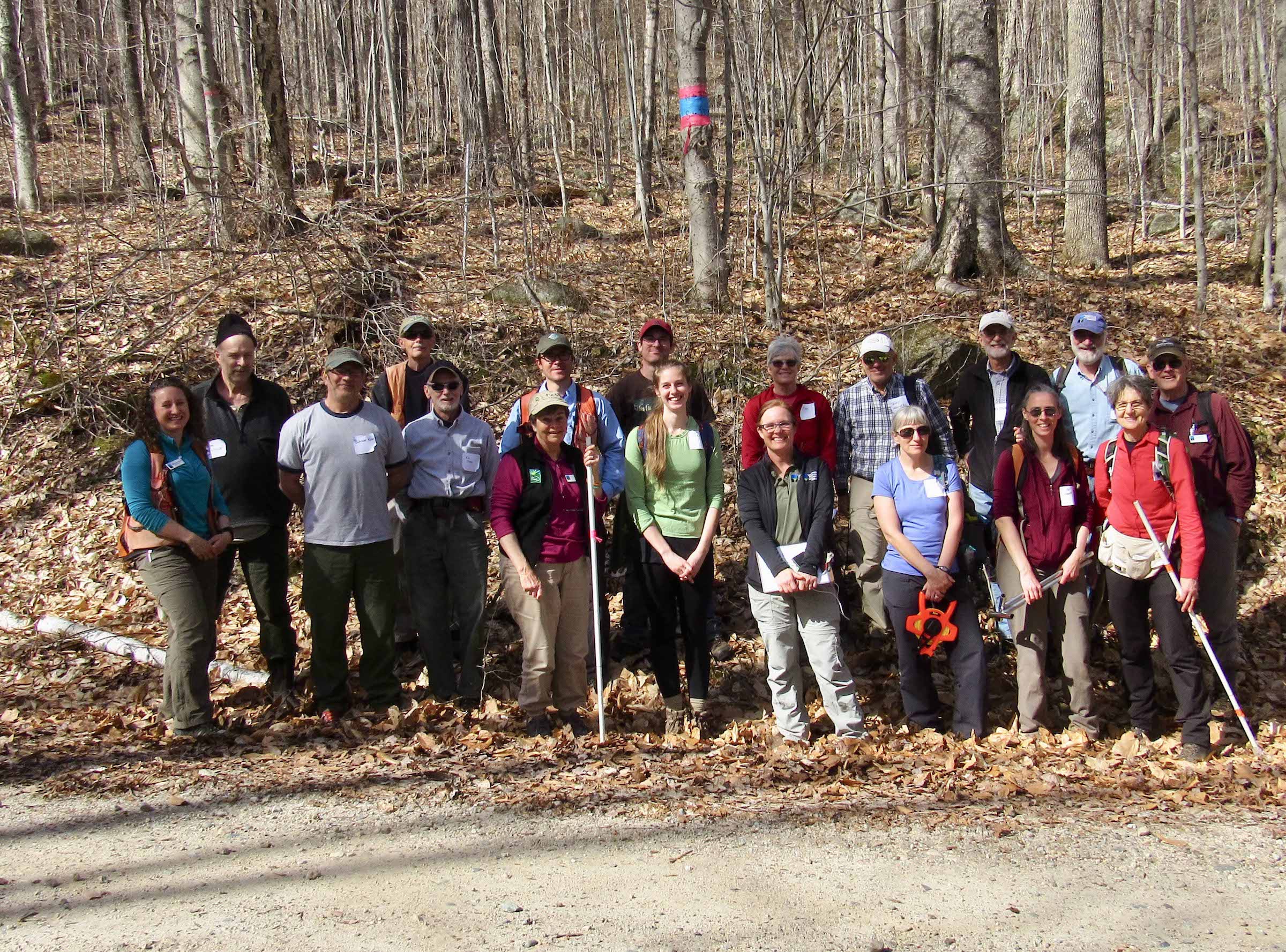Sugar Maple (Acer saccharum) is an essential species in northern hardwood forests. These trees produce valuable timber, fantastic colored foliage, and America’s favorite pancake topping. They have many other important economic, ecological, and cultural values too. However, these trees may be struggling to regenerate in a changing climate.
Research at Hubbard Brook Experimental Forest shows sugar maple seedlings failing to thrive. Warming temperatures appear to be contributing factor. In response, the Society for the Protection of New Hampshire’s Forests (Forest Society) is partnering with Hubbard Brook Experimental Forest (HBEF) in a new citizen science project. The goal of this project is to determine the extent of sugar maple regeneration issues throughout New Hampshire. The USDA Northeast Climate Hub is excited to support the research and training of citizen science volunteers to further understand this issue.
Several studies have highlighted the effects of recent climate trends on sugar maple growth (Oswald et al. 2018; Nolet et al. 2018). Sugar maple roots are particularly susceptible to freezing damage, and oddly, this type of damage is increasing. (Boutin and Roubitaille 1995; Tierney et al. 2001; Cleavitt et al. 2008). Reductions in snow pack, increasing as a result of climate change, increase susceptibility to root freeze damage resulting in reductions in tree growth (Maguire et al. 2017). Overall, this could pose considerable health risks for sugar maple (Reinmann et al. 2018). Understanding the complexity of sugar maple regeneration failure will benefit from additional research.
Long-term studies of sugar maple at HBEF have shown extremely high seedling mortality in one experimental watershed. Reasons for this are not entirely clear. It is likely that soil acidification, pests, competition with other species (like American beech) and climate change all play a role.

Is sugar maple regeneration failure happening beyond this site at Hubbard Brook?
The Forest Society and HBEF want to find out by making use of the many forested conservation properties that the Forest Society owns across the state of New Hampshire. In spring 2019, researchers established plots at Kauffmann Forest (Stark), Sudrabin Forest (Orange), Yatsevitch Forest (Cornish), and Monadnock Reservation (Dublin). Volunteer citizen scientists paired up with Hubbard Brook researchers to collect data on soils, sugar maple seedlings, and forest demographics. To get a better idea of what is happening, you can read through the project’s Sugar Maple Regeneration Citizen Science Training Guide. This detailed training guide aids the new scientists in learning about forest dynamics, tree identification, soil sampling, seedling assessment and the scientific process. As the project progresses over many years, citizen scientists will be working with Hubbard Brook staff and Cornell University students. Together they will track individual sugar maple seedlings over time and evaluate their health and vigor. The group hopes to better understand what roles climate change, tree species competition, predation, and pathogens play in sugar maple seedling survival. Additional study sites will be added in 2020; if you are interested in becoming a citizen scientist volunteer for this project, please contact Carrie Deegan at cdeegan@forestsociety.org. The Forest Society will be happy to answer any questions you may have about the project and volunteer commitment.

This project has been generously supported by USDA Northeast Climate Hub, the National Science Foundation (Long Term Ecological Research and Public Engagement with Science Grants), and Cornell University (Engaged Cornell Grant).
Boutin, R., & Robitaille, G. (1995). Increased soil nitrate losses under mature sugar maple trees affected by experimentally induced deep frost. Canadian Journal of Forest Research, 25(4), 588-602. Doi: 10.1139/x95-066.
Cleavitt, N. L., Fahey, T. J., Groffman, P. M., Hardy, J. P., Henry, K. S., & Driscoll, C. T. (2008). Effects of soil freezing on fine roots in a northern hardwood forest. Canadian Journal of Forest Research, 38(1), 82-91.
Maguire, T. J., Templer, P. H., Battles, J. J., & Fulweiler, R. W. (2017). Winter climate change and fine root biogenic silica in sugar maple trees (Acer saccharum): Implications for silica in the Anthropocene. Journal of Geophysical Research: Biogeosciences, 122(3), 708-715.
Nolet, P., & Kneeshaw, D. (2018). Extreme events and subtle ecological effects: lessons from a long‐term sugar maple–American beech comparison. Ecosphere, 9(7), e02336. Doi: 10.1002/ecs2.2336.
Oswald, E. M., Pontius, J., Rayback, S. A., Schaberg, P. G., Wilmot, S. H., & Dupigny-Giroux, L. A. (2018). The complex relationship between climate and sugar maple health: Climate change implications in Vermont for a key northern hardwood species. Forest Ecology and Management, 422, 303-312. Doi: 10.1016/j.foreco.2018.04.014.
Reinmann, A. B., Susser, J. R., Demaria, E. M., & Templer, P. H. (2019). Declines in northern forest tree growth following snowpack decline and soil freezing. Global change biology, 25(2), 420-430. Doi: 10.1111/gcb.14420
Tierney, G. L., Fahey, T. J., Groffman, P. M., Hardy, J. P., Fitzhugh, R. D., & Driscoll, C. T. (2001). Soil freezing alters fine root dynamics in a northern hardwood forest. Biogeochemistry, 56(2), 175-190.

